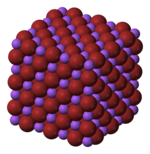Sodium bromide
 |
|
 |
|
| Names | |
|---|---|
|
IUPAC name
Sodium bromide
|
|
| Identifiers | |
|
7647-15-6 13466-08-5 (dihydrate) |
|
| 3D model (Jmol) | Interactive image |
| ChEMBL |
ChEMBL1644694 |
| ChemSpider |
22712 |
| ECHA InfoCard | 100.028.727 |
| PubChem | 253881 |
| RTECS number | VZ3150000 |
| UNII |
LC1V549NOM |
|
|
|
|
| Properties | |
| BrNa | |
| Molar mass | 102.89 g·mol−1 |
| Appearance | White powder, hygroscopic |
| Density | 3.21 g/cm3 (anhydrous) 2.18 g/cm3 (dihydrate) |
| Melting point | 747 °C (1,377 °F; 1,020 K) (anhydrous) 36 °C (97 °F; 309 K) (dihydrate) decomposes |
| Boiling point | 1,390 °C (2,530 °F; 1,660 K) |
| 71.35 g/100 mL (−20 °C) 79.52 g/100 mL (0 °C) 94.32 g/100 mL (25 °C) 104.9 g/100 mL (40 °C) 116.2 g/100 mL (100 °C) |
|
| Solubility | Soluble in alcohol, liquid ammonia, pyridine, hydrazine, SO2, amine Insoluble in acetone, acetonitrile |
| Solubility in methanol | 17.3 g/100 g (0 °C) 16.8 g/100 g (20 °C) 16.1 g/100 g (40 °C) 15.3 g/100 g (60 °C) |
| Solubility in ethanol | 2.45 g/100 g (0 °C) 2.32 g/100 g (20 °C) 2.29 g/100 g (30 °C) 2.35 g/100 g (70 °C) |
| Solubility in formic acid | 19.3 g/100 g (18 °C) 19.4 g/100 g (25 °C) |
| Solubility in glycerol | 38.7 g/100 g (20 °C) |
| Solubility in dimethylformamide | 3.2 g/100 g (10.3 °C) |
| Vapor pressure | 1 torr (806 °C) 5 torr (903 °C) |
| −41.0·10−6 cm3/mol | |
| Thermal conductivity | 5.6 W/m·K (150 K) |
|
Refractive index (nD)
|
1.6428 (24 °C) nKrF = 1.8467 (24 °C) nHe–Ne = 1.6389 (24 °C) |
| Viscosity | 1.42 cP (762 °C) 1.08 cP (857 °C) 0.96 cP (937 °C) |
| Structure | |
| Cubic | |
|
a = 5.97 Å
|
|
| Thermochemistry | |
| 51.4 J/mol·K | |
|
Std molar
entropy (S |
86.82 J/mol·K |
|
Std enthalpy of
formation (ΔfH |
−361.41 kJ/mol |
|
Gibbs free energy (ΔfG˚)
|
−349.3 kJ/mol |
| Hazards | |
| Safety data sheet | External MSDS |
| R-phrases | R36 |
| S-phrases | (S2), S24/25, S46 |
| NFPA 704 | |
| Flash point | 800 °C (1,470 °F; 1,070 K) |
| Lethal dose or concentration (LD, LC): | |
|
LD50 (median dose)
|
3500 mg/kg (rats, oral) |
| Related compounds | |
|
Other anions
|
Sodium fluoride Sodium chloride Sodium iodide Sodium astatide |
|
Other cations
|
Lithium bromide Potassium bromide Rubidium bromide Caesium bromide Francium bromide |
|
Except where otherwise noted, data are given for materials in their standard state (at 25 °C [77 °F], 100 kPa).
|
|
|
|
|
| Infobox references | |
Sodium bromide is an inorganic compound with the formula NaBr. It is a high-melting white, crystalline solid that resembles sodium chloride. It is a widely used source of the bromide ion and has many applications.
NaBr crystallizes in the same cubic motif as NaCl, NaF and NaI. The anhydrous salt crystallizes above 50.7 °C. salts (NaBr·2H2O) crystallize out of water solution below 50.7 °C.
NaBr is produced by treating sodium hydroxide with hydrogen bromide.
Sodium bromide can be used as a source of the chemical element bromine. This can be accomplished by treating an aqueous solution of NaBr with chlorine gas:
Sodium bromide is the most useful inorganic bromide in industry. It is also used as a catalyst in TEMPO-mediated oxidation reactions.
Also known as Sedoneural, sodium bromide has been used as a hypnotic, anticonvulsant, and sedative in medicine, widely used as an anticonvulsant and a sedative in the late 19th and early 20th centuries. Its action is due to the bromide ion, and for this reason potassium bromide is equally effective. In 1975, bromides were removed from drugs in the U.S. such as Bromo-Seltzer due to toxicity.
Sodium bromide is widely used for the preparation of other bromides in organic synthesis and other areas. It is a source of the bromide nucleophile to convert alkyl chlorides to more reactive alkyl bromides by the Finkelstein reaction:
Once a large need in photography, but now shrinking, the photosensitive salt silver bromide is prepared using NaBr.
...
Wikipedia

